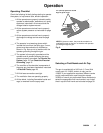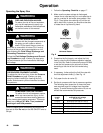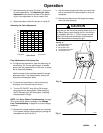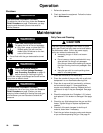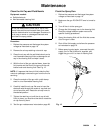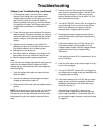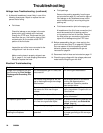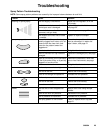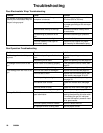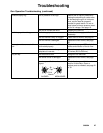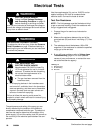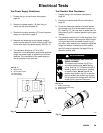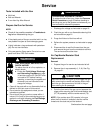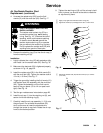
24 308584
Troubleshooting
Voltage Loss Troubleshooting (continued)
11. A dielectric breakdown is most likely in one of the
following three areas. Repair or replace the com-
ponent that is failing.
D Fluid hose
Check for leakage or any bulges in the outer
jacket, which may indicate a pin-hole leak
through the PTFE layer. Disconnect the fluid
hose from the gun, and look for signs of fluid
contamination on the outside of the PTFE
portion of the fluid tube.
Inspect the end of the hose connected to the
voltage block. Look for cuts or nicks.
Make sure the hose is properly stripped; see
Fig. 4, page 12, for hose stripping dimensions.
Restrip or replace the hose.
D Fluid packings
Remove the packing assembly from the gun
as instructed on page 33, and look for signs of
fluid leakage or any blackened areas, which
would indicate arcing is occurring along the
packing rod.
D Fluid hose connection joint to the spray gun
A breakdown at the fluid hose connection joint
would be caused by fluid leaking past the
o-ring seals on the end of the hose. Remove
the hose at the gun connection and look for
signs of fluid leakage along the PTFE tube.
12. Before reassembling the gun, clean and dry the
gun fluid inlet tube (item 75 on page 46). Repack
the inner spacer of the fluid packing rod with
dielectric grease and reassemble the gun as
instructed on page 34.
13. Reconnect the fluid hose as instructed on page 12.
14. Check the gun voltage with the voltage probe and
meter before filling the gun with fluid.
Electrical Troubleshooting
Problem Cause Solution
Voltage is still present at the gun
after following the Fluid Voltage
Discharge and Grounding Pro-
cedure
Gun electrostatics (gun ES lever) are
not turned off.
Turn off the gun electrostatics.
Did not wait long enough for the volt-
age to discharge through the voltage
bleed resistor.
Wait a longer period of time before
touching the electrode with a
grounded rod. Check for possible
bleed resistor failure.
There is an air pocket in the fluid line
that leaves the fluid near the gun
isolated.
Determine the cause of the air pocket
and fix the problem. Purge the air out
of the fluid line.
Voltage isolation system failed. See the isolation system manual for
service information.
The operator gets a shock The operator is not properly grounded
or is near an ungrounded object.
Be sure the floor and the operator are
properly grounded; see Ground the
System, page 14.
The gun is not properly grounded. See Check the Electrical Ground-
ing, page 15.
The operator gets a shock when
touching the workpiece
The workpiece is not properly
grounded.
Clean the workpiece hangers; check
for proper grounding on the conveyor
or track




